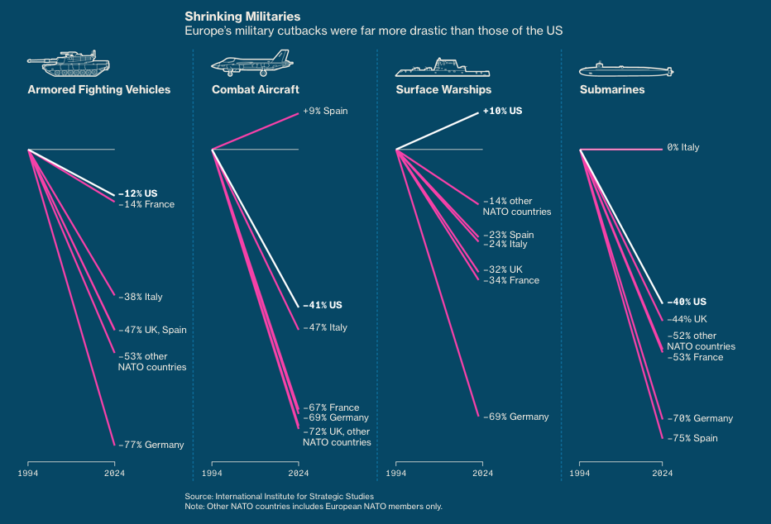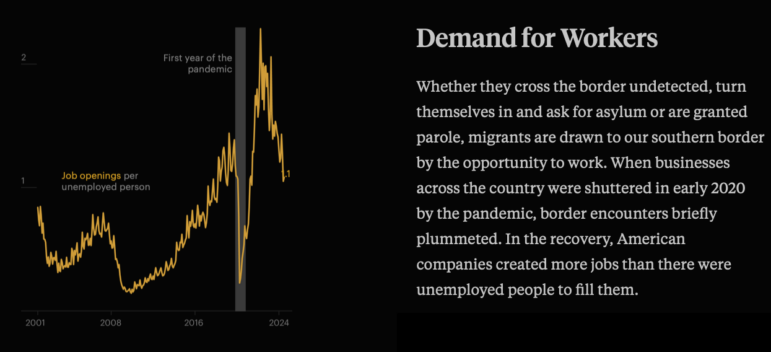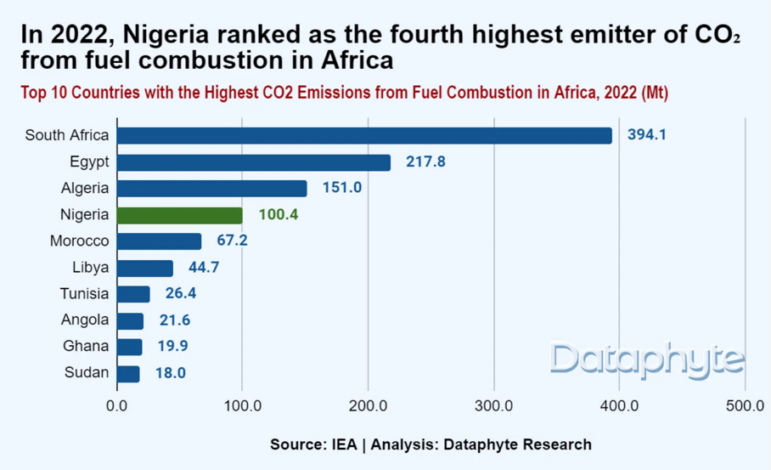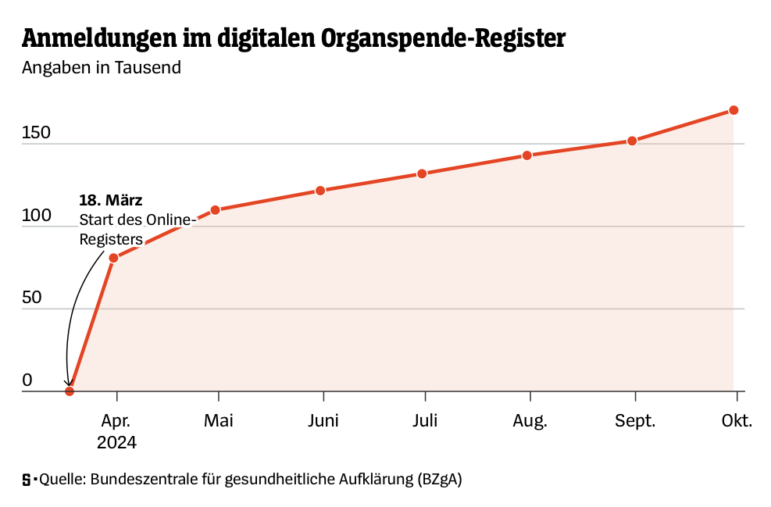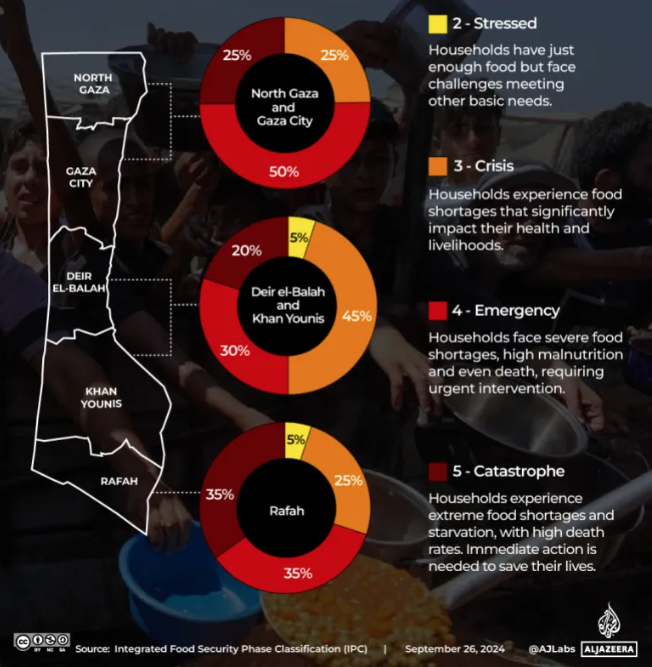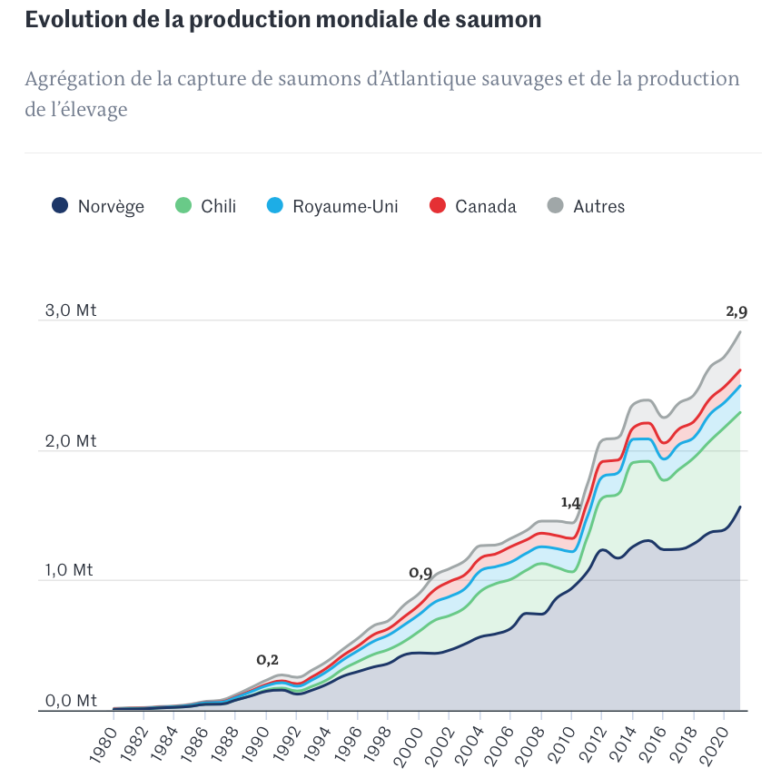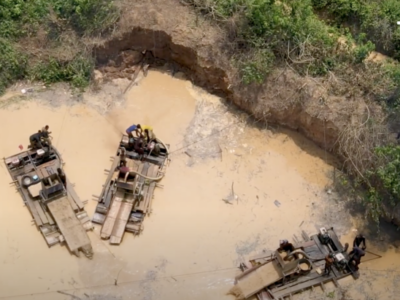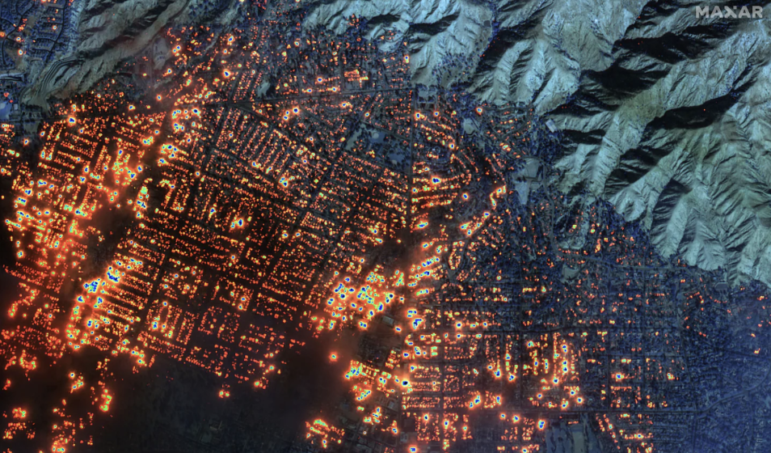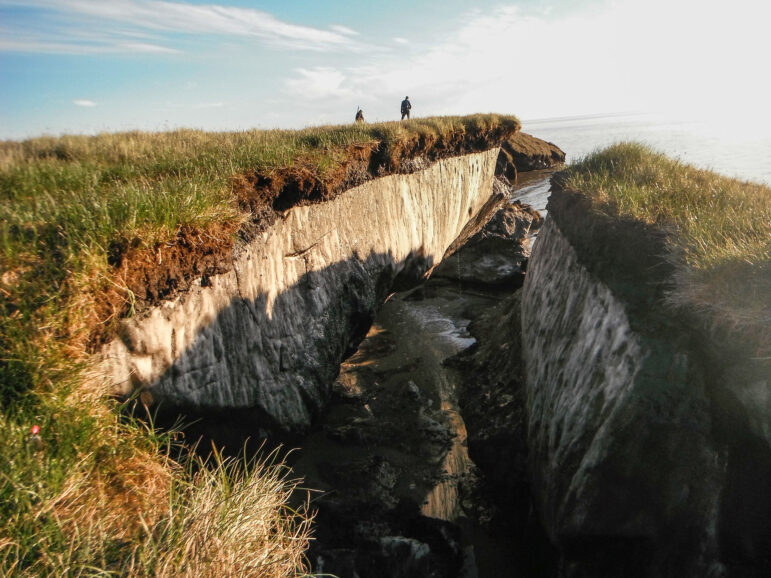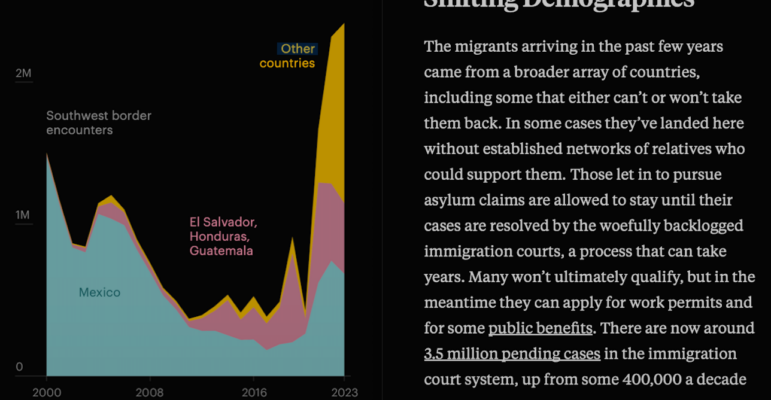
In a year in which nearly half of the world’s population has gone to the polls, we’ve finally reached the eve of the most talked-about election: the US presidential race. With less than a week to go, the outcome is still highly uncertain: candidates Donald Trump and Kamala Harris have been in a dead heat in the polls for weeks. The Financial Times has a comprehensive guide to the election, while The Washington Post explains in detail the seven battleground states that could influence the vote. This edition of our Top 10 in Data Journalism, which considered stories between October 14 and 27, also highlights a Bloomberg analysis of Europe’s dwindling military defense stocks; a La Nación mapping of crimes committed in Buenos Aires; a Dataphyte analysis of Nigeria’s efforts to reduce its carbon emissions; and an interactive showing the maze-like path to obtaining an abortion in each of the US states.
US Election Home Stretch
What began as a rematch of the 2020 Donald Trump vs Joe Biden election took an unexpected turn in late July, when Biden dropped out of the US presidential race and made way for his running mate, Kamala Harris, to run as the Democratic nominee. Now, with the election less than one week away, perhaps by the next edition of this column we will have a winner, but perhaps not — as we saw four years ago, the wait for the results of the polls could last for weeks. To help readers with everything they need to know before November 5, the Financial Times created a comprehensive guide to the US elections, which includes a compilation of several electoral polls, profiles of the two main candidates, explanations of how the Electoral College system works, as well as a summary of the main policies of Trump and Harris, graphs on the fundraising and spending of both campaigns and an overview of the allies of each side.
Furthermore, as is well known, US elections are decided by a small portion of voters, usually located in so-called “swing states,” which do not have a long history of voting for one of the nation’s two major political parties. Digging deeper into the seven states that will likely decide this year’s elections, The Washington Post analyzed the last three elections in each of these states, identifying the voting blocs that may be most important and the counties to watch in each state.
Europe’s Shrinking Military Defenses
The US election has also raised concerns on the other side of the Atlantic. Since Russia’s large-scale invasion of Ukraine, European countries have had to start thinking about the possibility of a full-scale war on their own territory. However, during the decades since the Cold War, European NATO members have been reducing their defense spending. What remains, according to experts interviewed by Bloomberg, are defense forces that could not face an invader without US support. In this scenario, Donald Trump’s return to the White House could pose a risk, since the former president has already made provocative comments about the possibility of not universally backing NATO allies. In addition, China’s rise as a military power and disputes over the territory of Taiwan — still, for the moment, a US ally — could also compromise military aid from the US. In this visual explanation, Bloomberg showed graphs on military spending and cuts in the armed forces of European countries, the number of each type of war vehicle, and the size of the troops these countries have, as well as comparisons with the US and Russia.
Buenos Aires Crime Map
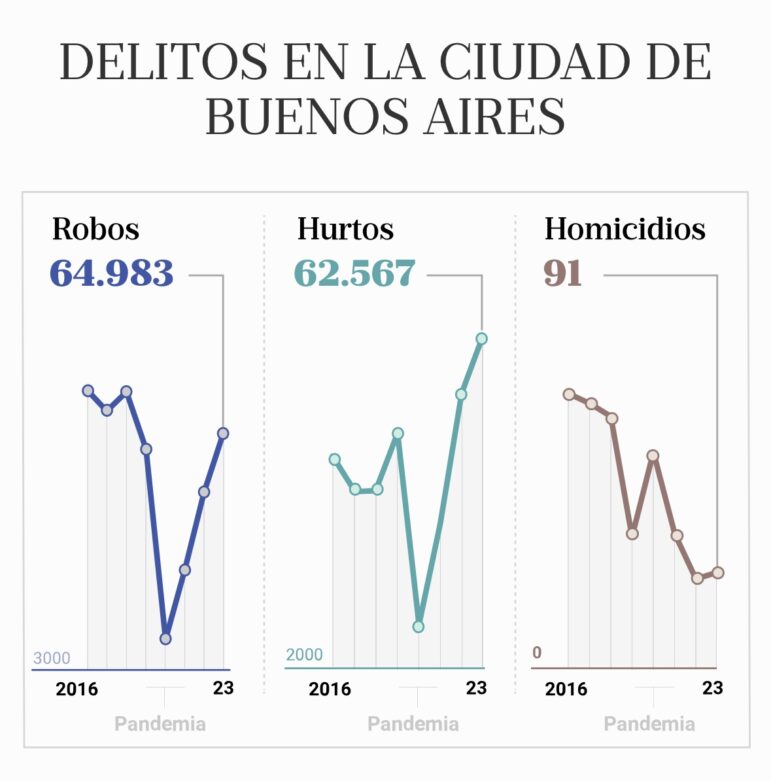
La Nacion mapped crimes in 2023 by neighborhood in downtown Buenos Aires (darker colors represent higher rates). Image: Screenshot, La Nacion
Are you planning a trip to Buenos Aires? This special report from the Argentine newspaper La Nación can help you — but not with conventional travel tips. On a map, they geolocated all the crimes registered in the city in 2023. You can also share your location in Buenos Aires to find out the local level of insecurity and the numbers and kinds of crimes that occurred in the area. It also presented graphs on the evolution of each type of crime. According to the report, while robberies and thefts increased in the capital last year, there are few murders, and they have been decreasing each year — making it one of the safest cities in Latin America in this regard. According to La Nación, one possible reason behind this is the low rate of use of firearms for robberies. To produce this special report, the team used public data from the crime map prepared by the government of Buenos Aires — a database where all police incidents reported in the city are uploaded with their geolocation. It’s even possible to find the most dangerous corner in the city, so you can avoid it.
New Faces of Immigration in the US
Immigration in the US has been a central topic in public opinion for decades, and this year a key part of the campaign speeches of both presidential candidates. ProPublica launched a deep-reporting series on the issue to understand what’s really happening at the border and in US cities — and how it’s been driven by policies enacted decades ago. In this first installment, the independent newsroom examines the historical context of immigration in the country, using local reporting and analysis of government data. Among its findings, ProPublica says that while the number of encounters at the border has increased over the past decade, they were much higher in the 2000s, and began to rise under Donald Trump. In addition, relatively few areas have seen significant numbers of migrants arriving compared to their populations. According to the report, while there has indeed been an increase in migrants crossing the US border, what has changed most about the crossings is who is arriving and how — many from new countries and in legal ways — rather than just the number of people. And despite it all, the country’s demand for workers remains near historic highs.
Nigeria’s Climate Report Card Ahead of COP29
In November, nearly 200 nations will gather for the 29th United Nations Climate Change Conference (COP29) in Baku, Azerbaijan, to review global climate efforts and present their updated national climate action plans under the Paris Agreement, which aims to limit global warming to 1.5°C above pre-industrial levels. It also provides an opportunity to assess how nations are progressing on their previous commitments and reducing their emissions. Dataphyte analyzed Nigeria’s situation through 2022 data, from several perspectives. According to the report, the country has some work to do. In 2022, the country was the fourth largest emitter of carbon dioxide — a major source of greenhouse gasses from fuel combustion — in Africa, which is closely linked to the country’s dependence on fossil fuels for energy. In 22 years, Nigeria’s emissions of this gas have increased by 127%. In addition to emissions from fuel combustion, carbon emissions come from other sectors of the economy, particularly transportation. According to Dataphyte, carbon emissions from residential sources are also partly driven by the access gap among Nigeria’s population, with only 25.6% of Nigerians having access to clean energy sources for cooking, for example.
(Lack of) Organ Donation in Germany
Organ donors have been able to register online in Germany since March 2024. However, according to an analysis by Der Spiegel, despite the new measure — which aims to increase the number of potential donors in the country, and to make it easier for hospitals to identify them — the need for donations has long gone unmet. So far, only around 0.2% of the German population — less than 200,000 people — has registered in the new online registry. Der Spiegel found that there is a discrepancy between positioning and attitude, which makes the gap between potential donors and those who want to donate a major problem. The team states that the need for donations far exceeds the number of actual transplants, and uses the figures on the waiting list for kidney transplants as an example. The newspaper also compares Germany’s position compared to other European countries: in 2023, the country ranked 27th in the number of organ donations per million inhabitants. According to Der Spiegel, one of the points that distinguishes Germany in this regard is its legal situation. While in most European countries anyone who does not actively oppose organ donation is automatically a potential donor, in Germany it is the opposite. Furthermore, the German population does not have a strong culture of organ donation that exists in other nations like Spain, which is often the European — and world — leader in organ donations.
Food Shortages and High Prices in Gaza
The conflicts in the Middle East do not appear to be approaching an end, and could be heading towards a wider scale, even after the killing of Hamas leader Yahya Sinwar by Israeli forces. Israeli Prime Minister Benjamin Netanyahu’s forces are expanding their ground offensive into Lebanon, targeting the Hezbollah group, in addition to recently attacking Iran. With Israel’s assault on Gaza continuing and humanitarian aid in the territory in short supply, Al Jazeera examined the cost of basic food supplies in the Strip. According to its report, at least 2.15 million people, or 96% of the population, are facing severe food shortages, with one in five facing starvation. In addition, the majority of the population does not have the means to buy essential goods, having lost their jobs when the region’s infrastructure collapsed or spent their savings on essential items at inflated prices. Before the war, for example, a dozen eggs cost US$3.50. Now, the item sells for US$32 in the south and about US$73 in the north. Fresh produce, including cucumbers and tomatoes — US$150 and US$180 per kilo (2.2. lbs) respectively — are among the most expensive, since most of Gaza’s farms and greenhouses were destroyed.
Language Manipulation on Telegram Channels
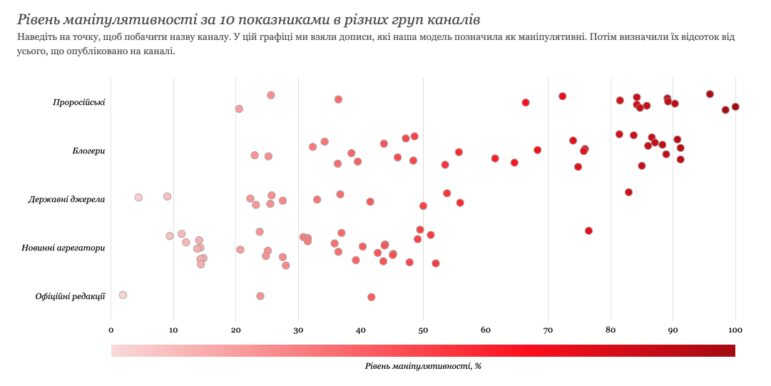
The level of Telegram text manipulability, by %, according to 10 indicators in different groups of channels. Channels studied (from top to bottom): pro-Russian, bloggers, state sources, news aggregators, and official news editions. Image: Screenshot, Texty.org.ua
Texty.org.ua has discovered that not only Russian propagandists manipulate language on Ukrainian Telegram channels. The outlet trained a large language model to detect the most common manipulation techniques in posts from 100 Ukrainian Telegram channels — the 50 most popular public channels in the news and media category and the 50 most popular in the politics category, using data from Telemetr.io. They found that almost half of the posts contained at least one type of manipulation — such as employing “emotional” or “loaded” words to evoke outrage or sympathy. The team shows, in graphs, the different manipulation techniques, the language structures they studied, and the percentage of manipulative language found in channels — divided into Pro-Russian, bloggers, state sources, news aggregators, and official news sites. Among the conclusions: the smallest amount of manipulation (2%) was found on the Telegram channel of Ukraine’s public broadcaster, while “the Russian channel Rezident, which continues to claim to be Ukrainian,” according to Texty, manipulated 90% of the posts they analyzed.
Navigating the US Abortion Maze, State by State
Another hotly debated topic among US presidential candidates is abortion rights, particularly following the Supreme Court’s Dobbs v. Jackson Women’s Health Organization decision in 2022, which repealed the federal right to an abortion. But, according to The Pudding, access to abortion in the US has rarely been straightforward, and the path to one is full of twists, turns, and obstacles. To illustrate how difficult it is to obtain the procedure, the outlet built a maze for each of the 50 American states (+1 for Washington, DC), where the difficulty is calculated by each state’s particular policies. After the Dobbs decision, 13 states banned abortion completely, others created additional obstacles to dismantle access, and others strengthened their rights policies. The special report also presents six individual abortion stories obtained from news reports. The mazes were generated with a depth-first search algorithm, with a size and difficulty that corresponded to the complexity score. While some mazes are fairly easy to complete, such as Washington, DC, and California, which have few obstacles to the procedure, others, like Arkansas and Texas, which have banned abortion with very limited exceptions, appear as near-impossible labyrinths to navigate
Captive Salmon Farming, By the Numbers
Le Monde warned about the dangers of the rapid growth of intensive salmon farming. In the Atlantic alone, production of the species has tripled in 20 years, rising from one million tons in the early 2000s to almost three million tons today. These numbers are mainly driven by the increase in farming in Norway and Chile, countries with cold waters suitable for salmon, but the development of “industrial farms” on land, which allow the installation of breeding ponds in places such as Saudi Arabia, is also growing. The report presents graphs on these and other key figures about the salmon industry, including the main salmon-consuming countries (with the US leading by far in total consumption and the Faroe Islands in per capita consumption), how industrial farming has replaced wild salmon fishing, and how multinationals control the salmon market. There are also some unpleasant figures, such as the high mortality rates on Norwegian farms, as a substantial proportion of fish die before reaching the maturity required for human consumption, and greenhouse gas emissions. The paper used data aggregated by French NGOs Seastemik and Data for Good.

